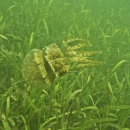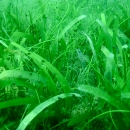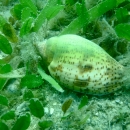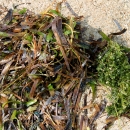Grants :: Regional Grant Facilities :: Living resources of the Gulf of Mannar: Assessment of key species and habitats for enhancing awareness and for conservation policy formulation
Living resources of the Gulf of Mannar: Assessment of key species and habitats for enhancing awareness and for conservation policy formulation
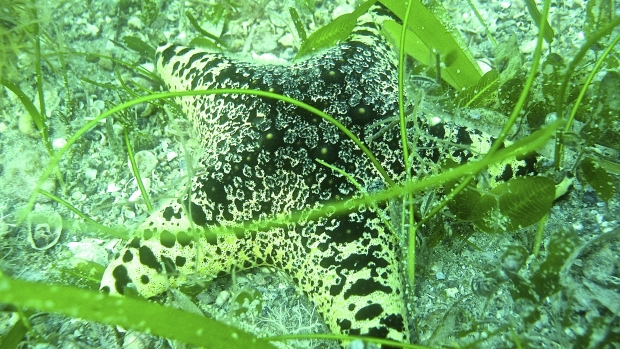
Biodiversity in the seagrass beds of the Gulf of Mannar and ... , Gulf of Mannar/Palk Bay, Tamil Nadu, India © SDMRI/MFF India, 2012
Objectives
- Knowledge base on living resources of Gulf of Mannar is enhanced
- Indo-Sri Lanka initiatives for sustainable use of living resources of GoM agreed upon and in place
- Project Management functioning well
Background
This regional initiative aims to address threats to marine and coastal biodiversity in the Gulf of Mannar, which stem from lack of information, awareness and inadequate policies. Biodiversity of the Gulf of Mannar provide many ecosystem goods and services, and these benefits are being compromised due to lack of information, awareness and inadequate policies. This issue gains more urgency as climate change will exacerbate threatsas well as act synergistically with existing threats. Current threats to biodiversity in the Gulf of Mannar include pollution, possible bio-invasion[1] (Kappaphycusalvarezii),unplannedcoastal development, illegalactivities like coral mining[2],dynamite fishing, dredging and siltation andover exploitation of biological resources.
A major underlying factor for biodiversity loss and increasing threats to species and ecosystems is the fact that information is scarce and there is little basis to formulate adequate laws, policies and conservation activities. It is necessary to identify information on species and ecosystems, threats, current awareness levels, and conservation needs, in order to implement conservation activities, create awareness and make recommendations for policy formulation and decision-making. This will in turn strengthen the policy and legal framework, and gain political will to implement successful conservation activities, which will enhance ecosystem services and direct benefits to local communities.
In the absence of a knowledge base and status, strong and robust policy and legal framework, technical knowledge and tools, financing and awareness, biodiversity in the Gulf of Mannar will likely decline to a ‘point of no return’. In such a situation,even abundant resources will not be sufficient to restore ecosystem services and benefits, thereby creating devastating environmental, social and economic implications for both India and Sri Lanka.
The proposed project will seek to build a knowledge base on coastal and marine biodiversity, identify values and threats, create awareness and identify gaps in legal and policy frameworks especially at a regional level, which hinder the long-term survival of biodiversity and its benefits in the Gulf of Mannar. It will also include pilot awareness and conservation initiatives, which can serve as case studies, with lessons learnt. This is vital for the successfully implementing larger conservation programmes, which will be backed by strong policy, legislation and political will.
The project will also complement the regional body of knowledge and facilitate knowledge transfer by ensuring the accessibility of currently available scientific and local knowledge, as well as tools and methodologies to the national and sub-national contexts, practitioners and decision-makers.
[1]Chandrasekaran, S., Nagendran, N. A., Pandiaraja, D., Krish- nankutty, N. &Kamalakannan, B. 2008.Bioinvasion of Kappaphycusalvarezii on corals in the Gulf of Mannar, India.Curr. Sci. 94:1167-1172.
[2]Wilhelmsson, D. , 2002 , Coral Reef Degradation in South Asia. in Linden, O., D. Souter, D. Wilhelmsson, and D. Obura (eds.). Coral degradation in the Indian Ocean: Status Report 2002. CORDIO, Department of Biology and Environmental Science, University of Kalmar, Kalmar, Sweden.pp 93-102
Target beneficiaries
At Govt. level: Resource management organizations – Department of Fisheries and Aquatic Resources and the Ministry of Fisheries and Aquatic Resources, Department of Wildlife Conservation, Ministry of Environment, Northwestern Provincial Environmental Authority, through management strategies and recommendations arising from the project. They will also receive updated information on living resources and their status through assessments done by the project.
The management authorities at the local level (Pradeshiya sabha) will also receive the same information but at a level which is useful for them to do resources management.
Community level: At the community level people will be involved in awareness raising and educational workshops. As the main goal of the project is to achieve sustainable use of marine resources, the project targets the community to adopt more responsible methods of resource exploitation. Through this the community will also benefit in the future.
Outputs
- Joint assessment report on living resources of GOM
- Assessment of ecosystem value of the resources of GoM
- Awareness campaign and capacity building on the importance of living resources of GoM and their sustainable use undertaken in both India and Sri Lanka
- An agreed Indo-Sri Lanka programme on sustainable use and conservation of living resources of GoM is prepared
- Project activities effectively implemented keeping in line with budget
Accomplishments and challenges
The project is only 4.5 months old (as at 14 Jan 2013), and is too early to report on this.
Contributions to cross-cutting themes
The project addresses the following cross cutting themes:
Climate change
Climate change concerns will be integrated at all levels of the project, as changing climate will no doubt impact the Gulf of Mannar. According to scientific research climate change is already impacting the marine environment as sea temperatures have risen over time. The project aims to increase resilience of communities because they will be vulnerable to threats from natural disasters and climate change – therefore each component of the project will take current and future climate into consideration, as ignoring such a vital aspect will result in the project being a failure in the mid-long term. The physical and biodiversity assessments, together with the assessment of threats will include sections that will focus exclusively threats from climate change. Capacity building and awareness material will also include climate change components where necessary. Therefore the project will ensure that the essential groundwork is laid to minimise the impact of climate change on the Gulf of Mannar. If the project is successfully implemented it will ensure that communities will be better equipped to be resilient to the impacts of climate change.
Gender equality
The project will aim to include equal numbers of male and female participants at workshops, awareness sessions etc, whenever possible. It must be noted however that certain specific sessions of capacity building and awareness could focus more on one gender than the other simply because certain livelihoods are gender specific. For example livelihoods associated with fisheries are often not carried out by women. However wherever possible the project will provide equal opportunities to both genders inproject activities.
Environmental law
The project will work within the existing laws and regulations in both countries and will respect the rule of law at all times. The project will, under Output 2, review and carry out a gap analysis, which will include an assessment of current environmental legislation. The aim of the exercise is to identify lapses in implementation or gaps in existing laws – these recommendations can serve to further improve environmental legislation. Additionally the awareness and capacity building materials, workshops and publications will all give due consideration to relevant environmental laws – and specifically highlight major legislation and its enforcement where necessary. If the project identifies lack of enforcement or knowledge on certain aspects by stakeholders, it will ensure to address these issues and include special components in the capacity building workshops. Additionally stakeholders and individuals involved in the enforcement of environmental law will also be included as target groups and invitees to workshops.
Poverty
Overall, the project will contribute to poverty reduction through the promotion of sustainable use of resources. The project will also increase resilience and enhance ecosystems services through the proposed activities.Many of the proposed activities – such as the pilot interventions and policy recommendations will support sustainable livelihoods in the medium and long-term.
Lessons Learned
The project is ongoing and is too early to document lessons learned.
Country
Location
Gulf of Mannar
Topic
- Knowledge for Management
- Marine Protected Areas
- Economic Valuation
- Strategies for Management
- Capacity Building
- Integrated Coastal Planning
- Community Resilence
Duration
1st Sep 2012 to 31st Dec 2014
MFF Grant Amount
$ 200,000.00
Co-financing Partner
$ 29,905 (IUCN India)
$ 29,905 (IUCN Sri Lanka)
Implementing Partner
IUCN India
IUCN Sri Lanka
Related Images
Related Publications
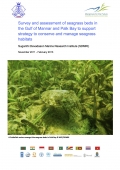
Survey and assessment of seagrass beds in the Gulf of Mannar and Palk Bay to support strategy to conserve and manage seagrass habitats
Author: SDMRI/MFF India
Publisher: SDMRI/MFF India
Posted on: 16th Sep 2013
Category:
Size: 1.9 MB

The Gulf of Mannar and its surroundings
A Resource book for teachers in the Mannar District
Author: Sriyanie Miththapala
Publisher: IUCN Sri Lanka
Posted on: 12th Nov 2012
Category:
Size: 2.7 MB
